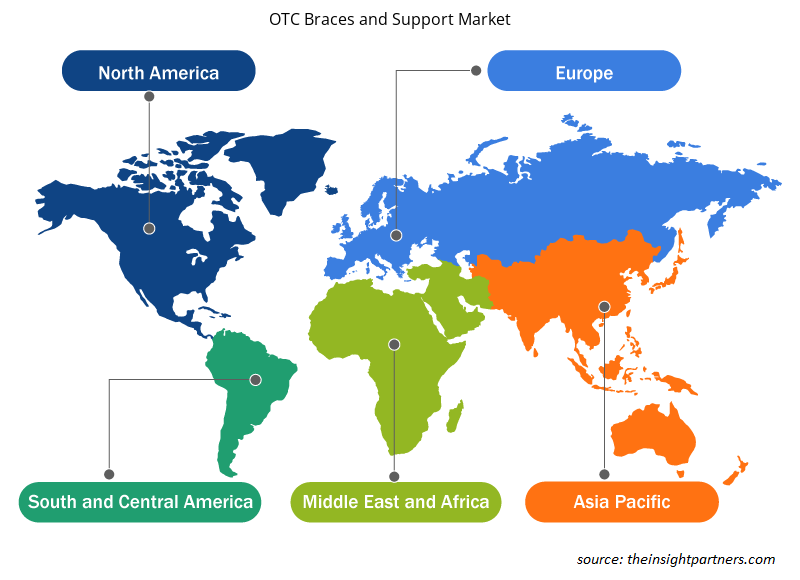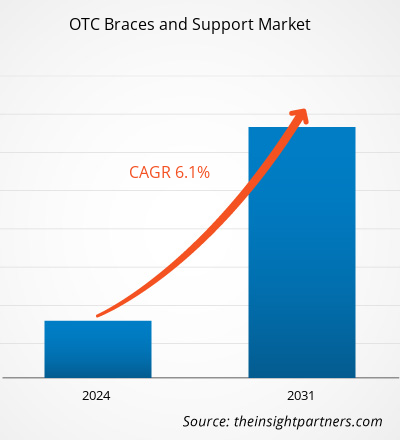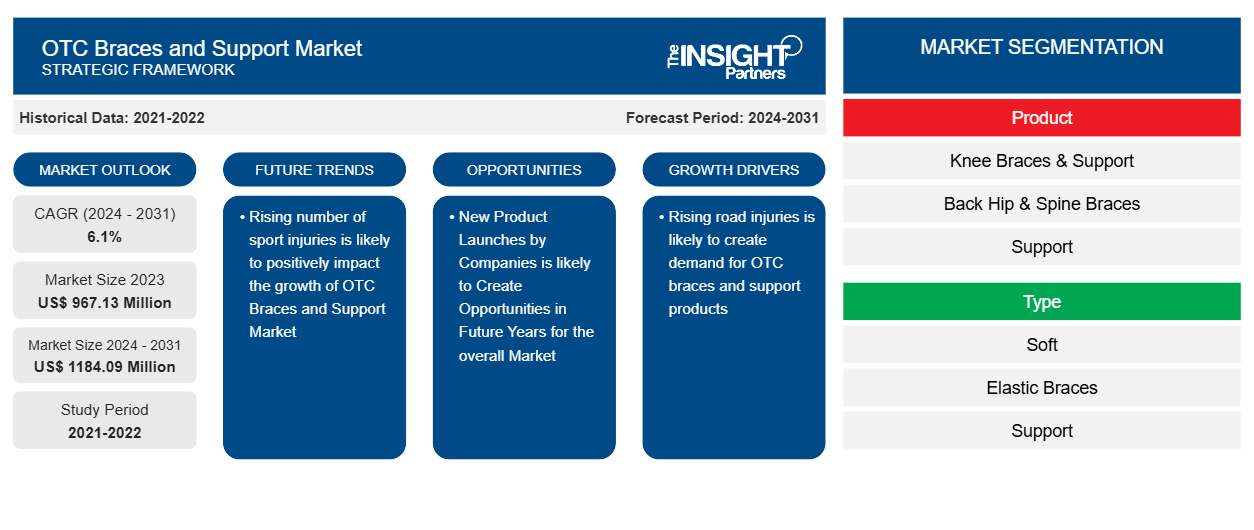Si prevede che il mercato dei tutori e dei supporti OTC raggiungerà i 1.184,09 milioni di $ USA entro il 2031, rispetto ai 967,13 milioni di $ USA del 2023. Si prevede che il mercato registrerà un CAGR del 6,1% nel 2024-2031. L'aumento degli infortuni stradali e la crescente domanda di partecipazione sportiva rimarranno probabilmente una tendenza del mercato dei tutori e dei supporti OTC.CAGR of 6.1% in 2024–2031. Rising road injuries and growing demand in sports participation is likely to remain an OTC braces and support market trend.
Analisi del mercato dei tutori e dei supporti da banco
Secondo il National Safety Council, sebbene le motociclette rappresentino fino al 3% di tutti i veicoli immatricolati e lo 0,7% di tutti i chilometri percorsi negli Stati Uniti, i motociclisti hanno rappresentato il 14,6% di tutti i decessi stradali e il 3,5% di tutti i feriti nell'anno 2022. Un fattore comune che influenza direttamente le tendenze della mortalità in moto è l'uso del casco. I decessi tra motociclisti e passeggeri sono aumentati dell'1% dal 2021 al 2022, mentre il tasso per 100 milioni di miglia percorse è diminuito del 16%. Il tasso di mortalità diminuisce nel 2022 a causa di un aumento del 21% delle miglia percorse. Negli ultimi 10 anni, i decessi sono aumentati del 32%, mentre i tassi di mortalità si sono drasticamente ridotti del 13%. Il numero di decessi in motocicletta è attualmente pari a 6.218 e il tasso è di 26,16 per 100 milioni di miglia percorse. Secondo l'Action Sports EMS, è stato segnalato che le lesioni cervicali della colonna vertebrale derivanti da incidenti motociclistici di qualsiasi tipo hanno l'82% di probabilità in più di verificarsi quando si guida senza un collare cervicale. Pertanto, si prevede che il numero crescente di incidenti motociclistici guiderà il mercato globale dei tutori e dei supporti OTC.
Panoramica del mercato dei tutori e dei supporti da banco
La crescente prevalenza di disturbi ortopedici sia nelle economie sviluppate che in quelle in via di sviluppo, unita alla crescente domanda di partecipazione sportiva tra i millennial, sta guidando la domanda di tutori e prodotti di supporto OTC. Tuttavia, l'efficacia clinica limitata è uno dei fattori che sta influenzando in modo critico la crescita del mercato dei tutori e dei supporti OTC.
Personalizza questo report in base alle tue esigenze
Riceverai la personalizzazione gratuita di qualsiasi report, comprese parti di questo report, o analisi a livello nazionale, pacchetto dati Excel, oltre a usufruire di grandi offerte e sconti per start-up e università
-
Scopri le principali tendenze di mercato in questo rapporto.Questo campione GRATUITO includerà analisi di dati che spaziano dalle tendenze di mercato alle stime e alle previsioni.
Driver e opportunità del mercato dei tutori e dei supporti da banco
Aumento del numero di infortuni sportivi a favore del mercato
Secondo la John Hopkins Medicine, nel 2022, circa 30 milioni di bambini e adolescenti partecipavano a qualche forma di sport organizzato negli Stati Uniti e ogni anno si verificano oltre 3,5 milioni di infortuni. Questi tipi di infortuni causano una certa perdita di tempo di partecipazione e sono probabili infortuni comuni come distorsioni e stiramenti. Tutti i tipi di sport hanno un potenziale di infortunio, sia a causa del trauma del contatto con altri giocatori sia a causa dell'uso eccessivo o improprio di una parte del corpo. I tutori e il supporto OTC forniscono un supporto mirato alle aree vulnerabili come ginocchia, gomiti, polsi e caviglie, riducendo il rischio di stiramenti e distorsioni. Pertanto, il crescente numero di infortuni sportivi negli Stati Uniti sta contribuendo alla crescita del mercato dei tutori e del supporto OTC.U.S. , and over 3.5 million injuries occurs each year. These types of injuries cause some loss of time of participation and common injuries such as sprains and strains are likely to occur. All sport types have a potential for injury, whether from the trauma of contact with other players or from overuse or misuse of a body part. The OTC braces and support provide targeted support to vulnerable areas such as the knees, elbows, wrists, and ankles, reducing the risk of strains and sprains. Thus, rising number of
Il lancio di nuovi prodotti probabilmente darà impulso alla crescita complessiva del mercato degli apparecchi ortodontici da banco e ne sosterrà la crescita
A marzo 2021, la società GSK Consumer ha lanciato un tutore per ginocchio potenziato digitalmente noto come VoltActive dopo una campagna di marketing durata un anno tramite approcci tradizionali e media digitali. Il prodotto può essere acquistato esclusivamente su Amazon. Man mano che le persone si impegnano di più per rimanere attive e fare esercizio, prodotti come VoltActive aiutano ad alleviare il dolore, ripristinare il movimento e ridurre l'infiammazione. Tale fattore è responsabile della crescita delle dimensioni del mercato dei tutori e del supporto OTC.GSK Consumer company launched a digitally enhanced VoltActive after a yearlong marketing campaign via traditional approaches and digital media. The product can be bought exclusively on Amazon. As people engages more to stay active and exercise, products such as VoltActive helps in relieving pain, restore movement, and reduces inflammation. Such a factor is responsible for the growth of the OTC braces and support market size.
Analisi della segmentazione del rapporto di mercato sui tutori e supporti OTC
I segmenti chiave che hanno contribuito alla derivazione dell'analisi di mercato dei tutori e dei supporti da banco sono l'applicazione e l'utente finale.
- In base all'applicazione, il mercato dei tutori e dei supporti OTC è stato segmentato in riparazione di lesioni ai legamenti, cure preventive, osteoartrite, terapia compressiva e altre applicazioni. Il segmento delle cure preventive ha detenuto la quota maggiore del mercato nel 2023; è probabile che lo stesso segmento segua un trend simile nel mercato durante il periodo di previsione.
- In base all'utente finale, il mercato dei tutori e dei supporti OTC è stato segmentato in ospedali, centri chirurgici ambulatoriali, cliniche specialistiche e altri. Il segmento ospedaliero ha detenuto la quota maggiore del mercato nel 2023. Tuttavia, si stima che le cliniche specialistiche registreranno il CAGR più elevato nel mercato durante il periodo di previsione.CAGR in the market during the forecast period.
Analisi della quota di mercato dei tutori e dei supporti da banco per area geografica
L'ambito geografico del rapporto sul mercato degli apparecchi ortodontici e dei supporti da banco è suddiviso principalmente in cinque regioni: Nord America, Asia Pacifico, Europa, Medio Oriente e Africa e Sud America/Sud e Centro America.
In base alla geografia, il mercato dei tutori e dei supporti OTC è segmentato in cinque regioni chiave: Nord America, Europa, Asia Pacifico, Sud e Centro America e Medio Oriente e Africa. Il mercato dei tutori e dei supporti OTC del Nord America è stato analizzato in base a tre paesi principali: Stati Uniti, Canada e Messico. Si stima che il mercato dei tutori e dei supporti OTC degli Stati Uniti detenga la quota di mercato più ampia durante il periodo di previsione. La commercializzazione di nuovi dispositivi ortopedici, scenari di rimborso favorevoli e la crescente partecipazione alle attività sportive da parte dei millennial sono alcuni fattori che favoriscono la crescita del mercato dei tutori e dei supporti OTC nella regione degli Stati Uniti.
Approfondimenti regionali sul mercato dei tutori e dei supporti da banco
Le tendenze regionali e i fattori che influenzano il mercato di OTC Braces and Support durante il periodo di previsione sono stati ampiamente spiegati dagli analisti di Insight Partners. Questa sezione discute anche i segmenti e la geografia del mercato di OTC Braces and Support in Nord America, Europa, Asia Pacifico, Medio Oriente e Africa e America centrale e meridionale.

- Ottieni i dati specifici regionali per il mercato dei tutori e dei supporti da banco
Ambito del rapporto di mercato sui tutori e supporti OTC
| Attributo del report | Dettagli |
|---|---|
| Dimensioni del mercato nel 2023 | 967,13 milioni di dollari USA |
| Dimensioni del mercato entro il 2031 | 1184,09 milioni di dollari USA |
| CAGR globale (2024 - 2031) | 6,1% |
| Dati storici | 2021-2022 |
| Periodo di previsione | 2024-2031 |
| Segmenti coperti |
Per Prodotto
|
| Regioni e Paesi coperti |
America del Nord
|
| Leader di mercato e profili aziendali chiave |
|
Densità degli attori del mercato: comprendere il suo impatto sulle dinamiche aziendali
Il mercato dei tutori e dei supporti OTC sta crescendo rapidamente, spinto dalla crescente domanda degli utenti finali dovuta a fattori quali l'evoluzione delle preferenze dei consumatori, i progressi tecnologici e una maggiore consapevolezza dei benefici del prodotto. Con l'aumento della domanda, le aziende stanno ampliando la propria offerta, innovando per soddisfare le esigenze dei consumatori e capitalizzando sulle tendenze emergenti, il che alimenta ulteriormente la crescita del mercato.
La densità degli operatori di mercato si riferisce alla distribuzione di aziende o società che operano in un particolare mercato o settore. Indica quanti concorrenti (operatori di mercato) sono presenti in un dato spazio di mercato in relazione alle sue dimensioni o al valore di mercato totale.
Le principali aziende che operano nel mercato dei tutori e dei supporti da banco sono:
- Azienda 3M
- DJO Global, Inc.
- Uccello e Cronin
- Essità
- Zimmer Biomet Holdings, Inc
- Tutore da banco
Disclaimer : le aziende elencate sopra non sono classificate secondo un ordine particolare.

- Ottieni una panoramica dei principali attori del mercato dei tutori e dei supporti da banco
Notizie e sviluppi recenti sul mercato dei tutori e dei supporti da banco
Il mercato OTC Braces and Support viene valutato raccogliendo dati qualitativi e quantitativi post-ricerca primaria e secondaria, che includono importanti pubblicazioni aziendali, dati associativi e database. Di seguito è riportato un elenco degli sviluppi nel mercato per innovazioni, espansione aziendale e strategie:
- A luglio 2023, OS1st ha lanciato il suo KS8 Performance Knee Brace che aiuta a stabilizzare l'articolazione del ginocchio durante il percorso di guarigione da un intervento chirurgico al ginocchio o da un dolore articolare continuo. Il prodotto è dotato di un anello rotuleo leggero e stecche rimovibili con una combinazione ultra morbida di materiali in micro-nylon e LYCRA Spandex e impugnature in gel di silicone ipoallergenico antiscivolo per ridurre lo scivolamento e consentire un'usura continua. (Fonte: OS1st., Blog)
Copertura e risultati del rapporto di mercato sui tutori e supporti OTC
Il rapporto "Dimensioni e previsioni del mercato dei tutori e dei supporti OTC (2021-2031)" fornisce un'analisi dettagliata del mercato che copre le seguenti aree:
- Dimensioni e previsioni del mercato di tutori e supporti OTC a livello globale, regionale e nazionale per tutti i principali segmenti di mercato coperti dall'ambito
- Dinamiche di mercato come fattori trainanti, vincoli e opportunità chiave
- Tendenze del mercato degli apparecchi ortodontici e dei supporti da banco
- Analisi dettagliata delle cinque forze PEST/Porter e SWOT
- Analisi di mercato di OTC Braces and Support che copre le principali tendenze del mercato, il quadro globale e regionale, i principali attori, le normative e i recenti sviluppi del mercato
- Analisi del panorama del settore e della concorrenza dei tutori e dei supporti OTC che copre la concentrazione del mercato, l'analisi della mappa di calore, i principali attori e gli sviluppi recenti
- Profili aziendali dettagliati
- Analisi storica (2 anni), anno base, previsione (7 anni) con CAGR
- Analisi PEST e SWOT
- Valore/volume delle dimensioni del mercato - Globale, Regionale, Nazionale
- Industria e panorama competitivo
- Set di dati Excel
Report recenti
Testimonianze
Motivo dell'acquisto
- Processo decisionale informato
- Comprensione delle dinamiche di mercato
- Analisi competitiva
- Analisi dei clienti
- Previsioni di mercato
- Mitigazione del rischio
- Pianificazione strategica
- Giustificazione degli investimenti
- Identificazione dei mercati emergenti
- Miglioramento delle strategie di marketing
- Aumento dell'efficienza operativa
- Allineamento alle tendenze normative























 Ottieni un campione gratuito per - Mercato di apparecchi ortodontici e supporti da banco
Ottieni un campione gratuito per - Mercato di apparecchi ortodontici e supporti da banco